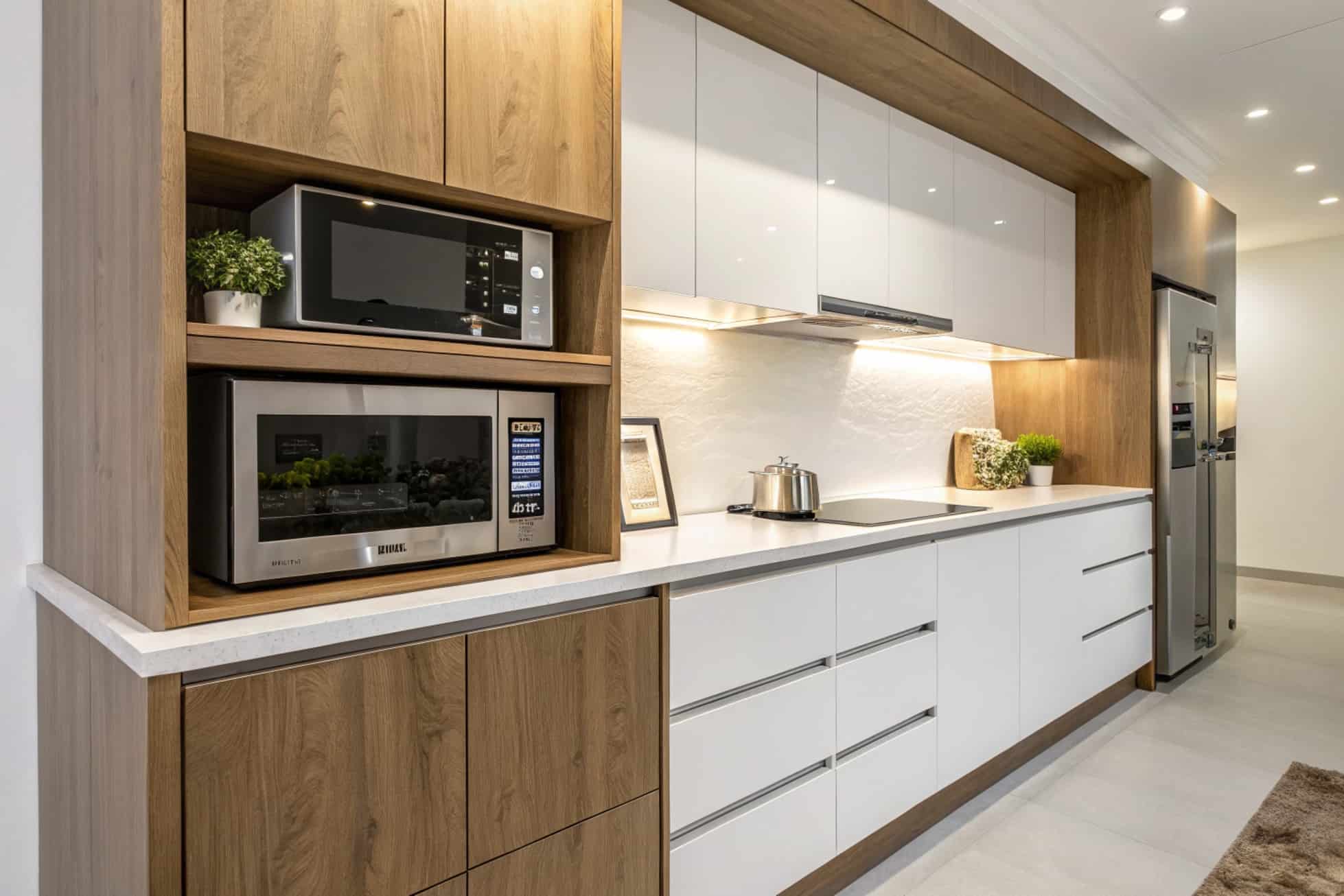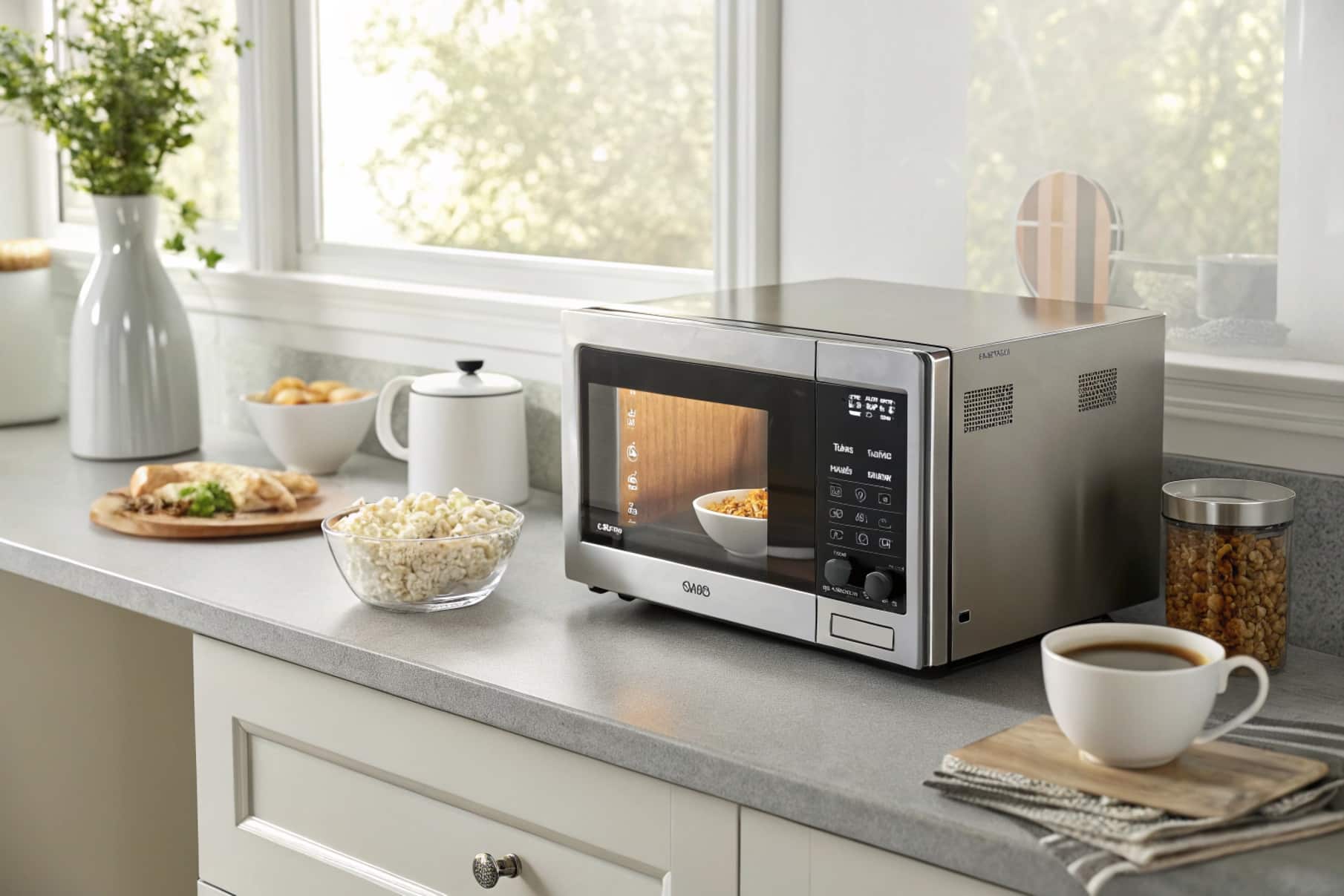The modern kitchen is no longer just a place to cook—it’s a carefully designed space that balances functionality, style, and technology. With more people upgrading their kitchen layouts, the demand for built-in appliances has significantly increased. One common request from homeowners is how to get the sleek look of a built-in microwave without replacing their existing countertop unit. Many want to maximize their space, especially in compact kitchens where every inch matters. Instead of replacing a working appliance, people are searching for smart ways to integrate what they already have.
In this article, we explore how a countertop microwave can be built into cabinetry safely and stylishly. You’ll learn about compatibility, installation tips, ventilation needs, aesthetic options, and everything in between. We’ve also included two tables for easier comparison and insight. Whether you’re redesigning your kitchen or simply trying to free up space, this guide has you covered.
What Exactly Is a Countertop Microwave?
A countertop microwave is a freestanding appliance designed to sit directly on your kitchen counter. It’s easy to set up, typically just requiring a power outlet. These microwaves come in many sizes and power levels and offer flexible use with little to no installation.
Features often include:
- Quick setup with no permanent installation
- Wide availability and affordability
- Portability and ease of replacement
Despite these advantages, they can take up valuable space in smaller kitchens, which leads many to consider installing them in cabinets or designated spaces.
What should you consider before turning a countertop microwave into a built-in unit?
The short answer is yes, many countertop microwaves can be built in—but only if certain conditions are met. You must ensure the unit can operate safely in an enclosed space without risk of overheating or damage.

Manufacturers often release trim kits for this purpose, which allow certain countertop models to be fitted neatly within cabinetry. These kits help provide proper ventilation and a finished look.It’s essential to verify compatibility with the specific microwave model before attempting installation. Improper setup can lead to performance issues or even void the manufacturer’s warranty.
Key Considerations Before Building a Countertop Microwave – Expert Tips Inside!
Ventilation Needs:
Microwaves need adequate airflow to operate safely. Blocking vents can cause the unit to overheat or fail prematurely. Always check the manual to see where vents are located—usually on the sides or back—and ensure the cabinet space provides enough clearance for proper air circulation and heat dissipation.
Trim Kit Availability:
Trim kits are essential for safely installing countertop microwaves into cabinetry. These kits provide a finished look and maintain airflow. However, not every model supports one. Before building in your unit, confirm with the manufacturer whether a trim kit exists for your model and follow the installation instructions carefully to avoid performance issues.
Size and Fit:
Cabinet dimensions must be suitable for the microwave’s width, depth, and height, plus recommended clearances. Installing a unit that’s too snug can lead to overheating, blocked airflow, or damage to surrounding cabinetry. Always measure carefully and ensure the microwave can fit securely without compromising ventilation or accessibility.
Countertop Microwave vs. Built-In Microwave:
| Feature | Countertop Microwave | Built-In Microwave |
| Installation | Freestanding (no setup required) | Installed in cabinets or walls |
| Portability | Easy to move | Fixed in place |
| Space Use | Takes up counter space | Frees up counter space |
| Ventilation Requirements | Needs open surroundings | Designed with internal ventilation |
| Aesthetic Appeal | Functional but not seamless | Sleek and modern appearance |
| Cost | Generally cheaper | More expensive (including install) |
| Trim Kit Compatibility | Limited to select models | Not needed |
How Do You Properly Build In a Countertop Microwave?
Step 1: Choose the Right Model
Not all countertop microwaves are made for built-in use. Look for models with front ventilation, clear cabinet installation guidance in the user manual, and compatibility with a trim kit. These features ensure the microwave can be enclosed safely without risking poor airflow or reduced performance.
Step 2: Measure Twice
Accurate measurements are key. Measure your microwave’s height, width, and depth, then compare those with your cabinet’s internal dimensions. Don’t forget to allow 1–2 inches of space on the sides and top for ventilation. A tight fit can trap heat and cause the microwave to overheat or shut down unexpectedly.
Step 3: Purchase a Trim Kit
A trim kit makes your microwave look built-in while maintaining proper airflow. If your microwave model supports one, buy a trim kit from the manufacturer or a trusted dealer. The kit typically includes frames and mounting tools to stabilize the unit and prevent gaps around the appliance inside the cabinet.
Step 4: Ensure Proper Ventilation
Microwaves generate heat and need consistent airflow. Do not block side or rear vents during installation. Use trim kits that include vent channels, and consider adding airflow cutouts at the back or top of the cabinet space to help prevent heat buildup and protect both the appliance and surrounding surfaces.
Step 5: Secure the Microwave
After confirming fit and ventilation, mount the microwave securely using the hardware from the trim kit. Tighten all brackets and ensure the unit doesn’t shift or lean. If you’re not confident with electrical components or mounting tools, hiring a professional ensures both safety and optimal performance of the appliance.
When Is It Not Recommended?
Although it’s technically possible, building in a countertop microwave is not always the best option. Here are situations where it may not work:
- Side or rear venting without trim kit: If the microwave vents from the sides or back and doesn’t support a trim kit, enclosing it may block airflow and cause the unit to overheat or malfunction.
- No nearby electrical outlet: Without a nearby power outlet, installation becomes inconvenient and potentially unsafe. Using extension cords for high-wattage appliances like microwaves increases the risk of overheating, electrical faults, or fire hazards.
- Insufficient cabinet space: Cabinets that are too tight or poorly ventilated trap heat and restrict airflow. This can reduce microwave efficiency, shorten its lifespan, and increase the chance of damage to both the unit and cabinetry.
- Not UL-listed for built-in use: If the microwave isn’t UL-listed or safety certified for enclosed installation, building it in could void the warranty and increase the risk of operational hazards, including electrical or fire incidents.
Manufacturer warning in manual: When the manual clearly states that the microwave is not designed for enclosed use, ignoring that guidance could lead to unsafe operation, overheating issues, or voided warranty coverage.
How Can I Tell If My Microwave Can Be Built In?
| Question | Yes | No |
| Does the model have a front-facing vent? | ✅ | ❌ |
| Is a trim kit available from the manufacturer? | ✅ | ❌ |
| Is the cabinet wide and deep enough? | ✅ | ❌ |
| Is airflow allowed around the unit? | ✅ | ❌ |
| Does the user manual allow built-in installation? | ✅ | ❌ |
| Is there a nearby power outlet? | ✅ | ❌ |
If you answered “No” to more than two items, it may be safer to keep your microwave on the countertop or consider a model designed for built-in installation.
What Are the Benefits of Using a Countertop Microwave as a Built-In?
- Maximizes counter space: By placing the microwave inside cabinetry, you free up valuable kitchen counter space. This allows you to better organize your cooking area, make room for other appliances, and create a cleaner, less cluttered overall kitchen environment.
- Creates a custom look: Building in a countertop microwave offers a sleek, high-end appearance that complements modern kitchen cabinetry. It delivers the polished aesthetic of a built-in model without requiring a full appliance upgrade, giving your kitchen a more cohesive and stylish look.
- Uses your current microwave: Instead of discarding a perfectly functional microwave, you can repurpose it into a built-in setup. This allows continued use of your existing appliance while enjoying the benefits of a built-in layout, saving time and reducing waste.
- Cost-effective upgrade: Purchasing a new built-in microwave and hiring a professional for installation can be expensive. Adapting your current countertop microwave with a trim kit is a budget-friendly alternative that provides similar functionality and visual appeal at a much lower cost.
- Flexible installation: Installing a countertop microwave in a cabinet using a trim kit offers flexibility. If your kitchen layout changes or you move to a new home, the microwave can be easily removed and reused without permanent modifications or replacement needs.
What Safety Precautions Should You Follow When Building In a Countertop Microwave?
Safety is essential when converting a countertop microwave into a built-in unit. Always ensure vents and fans are unobstructed to maintain proper airflow and prevent overheating. Avoid installing the unit near water sources to reduce electrical risks. Make sure cords aren’t bent or pinched, which could lead to damage over time.
The microwave should be secured firmly in place to prevent tilting or shifting. Only use microwave-safe cookware and avoid placing metal items inside, as they can cause sparks, fires, or internal damage to the unit.
What Are the Best Practices and Expert Tips for Building In a Countertop Microwave?
- Read the manual thoroughly: Always start with your microwave’s user manual. It provides specific installation instructions, clearance requirements, and safety warnings tailored to your exact model. Ignoring this guidance can lead to improper setup and potential hazards.
- Use manufacturer-approved accessories: Only use trim kits, brackets, and installation parts made for your specific microwave model. These are tested for safety and fit, unlike universal kits that may compromise airflow or stability.
- Leave breathing space: Even if you use a trim kit, your microwave still needs proper ventilation. Make sure to leave space on all sides, including the back and top, as specified in the manual to prevent overheating.
- Keep cords accessible: Avoid positioning the microwave where the power cord is difficult to reach. In case of electrical issues or emergencies, you should be able to unplug the appliance quickly and safely.
How Can You Future-Proof Your Kitchen with Microwave Choices?
If you’re planning a long-term kitchen upgrade, it’s wise to consider a true built-in microwave. These models are specifically engineered for enclosed installation, often featuring advanced options like convection cooking and sleek integration with premium cabinetry.
They offer a lasting solution for modern kitchens. However, if you’re not ready for a full renovation, turning a countertop microwave into a built-in setup is a smart, cost-effective way to maximize space now, while keeping the option open for future appliance upgrades.
FAQs:
1. Can you put a countertop microwave in a built-in spot?
Yes, you can place it in a built-in spot if the model supports front ventilation and has a compatible trim kit. Proper airflow is essential to avoid overheating, and the installation must follow the manufacturer’s safety and clearance guidelines.
2. Is there a difference between a countertop microwave and a built-in microwave?
Yes. Countertop microwaves are designed for open placement on surfaces, while built-in models are made to be enclosed in cabinetry. Built-in types usually offer trim kits, better ventilation design, and a more seamless look integrated with kitchen cabinetry.
3. Can I put a countertop microwave in a built-in space?
You can if the microwave is built-in capable. Ensure it vents from the front, not the sides or back, and use a trim kit to allow airflow. Always refer to the user manual before installing it in a cabinet space.
4. Can a countertop microwave be used in a cabinet?
Yes, but only if proper ventilation is maintained. The cabinet must allow airflow around the unit, especially if it vents from the back or sides. Using a manufacturer-approved trim kit can help ensure safety and effective heat dissipation.
5. What are the risks of building in a countertop microwave without proper setup?
Improper installation may block ventilation, leading to overheating, fire risk, or electrical damage. It can void the warranty and reduce the microwave’s lifespan. Always follow safety instructions and ensure compatibility before enclosing any countertop model.
Conclusion:
Building in a countertop microwave is both a practical and stylish solution when done with the right model, proper ventilation, and a compatible trim kit. It allows homeowners to save space, enhance kitchen aesthetics, and avoid unnecessary appliance upgrades.
By following safety precautions, expert tips, and manufacturer guidelines, you can confidently turn your countertop unit into a built-in feature that fits seamlessly into your kitchen layout—offering convenience today while allowing flexibility for future upgrades.
This approach not only extends the life of your current appliance but also adds long-term value to your kitchen. Make smart, informed choices, and your microwave setup will serve you efficiently for years to come.
Related post:



